
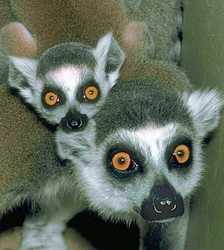
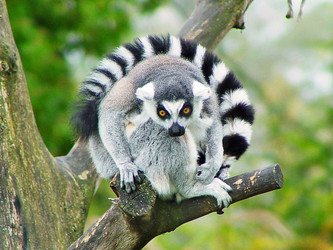

Lemur catta. Left: Captive female and infant, © 2000 Greg and Marybeth Dimijian. Center: Captive lemur in tree © 2005 Tambako The Jaguar. Right: Wild lemur in a small natural park, Madagascar, © 2005 Daniel
Introduction
Lemur catta, also known as the ring-tailed lemur, is a primate native to Madagascar. “Lemur” comes from the Latin word lemurs, meaning “ghosts”. It is called “ring-tailed” because of its distinctive alternating black and white bands along the tail. L. catta is one of the most well-known and recognizable species of lemurs.
Appearance
Ring-tailed lemurs have black skin, mostly covered by grey fur. They also have patches of white fur on their faces, ears, and underbelly. Their long tails have a fur pattern of alternating black and white rings. They have bright yellow or amber eyes, surrounded by mask-like black skin. Their snouts are long and fox-like, with whiskers and a moist black nose. They have fingernails, toe nails and opposable thumbs, adaptations for a life in the trees shared by many primates. They have a specialized tooth used for scraping during grooming. Both male and female L. catta measure about 42.5 cm in length, and weigh roughly 2.2 kg in the wild.


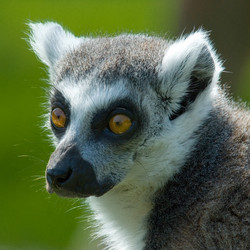
Left: Ring-tailed lemur sunbathing, © 2007 Gail Northumberland UK. Right: Ring-tailed lemur face, © 2007 Steve Harris.
Evolution & Classification
- Domain: Eukaryota
- Kingdom: Animalia
- Phylum: Chordata
- Subphylum: Vertebrata
- Class: Mammalia
- Order: Primates
- Suborder: Strepsirrhini
- Family: Lemuridae
- Genus: Lemur
- Species: Lemur catta
L. catta is the only species of the genus Lemur, but they share the family Lemuridae with many others. Their closest relatives are the gentle lemurs: the golden bamboo lemur, the grey gentle lemur and the broad-nosed gentle lemur. They are classified under the order of Primates, and of the suborder Strepsirrhini. Strepsirrhini split from other primates approximately 63 million years ago.


Primate phylogeny. © Information obtained from Tree of Life.
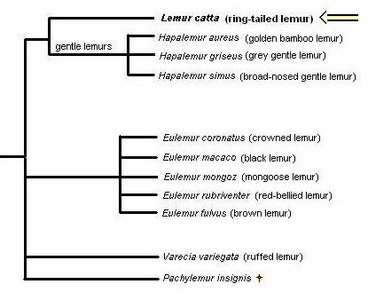
Lemuridae phylogeny. © Information obtained from Tree of Life.
Ring-tailed lemurs are prosimians. Prosimians are a paraphyletic group that includes all Strepsirrhini and Tarsii, the most "ancestral" of the primates. Prosimians once dominated the trees in many continents, but eventually were replaced by monkeys, who were stronger in the trees. They migrated to islands off the coast of Africa and Asia where the absence of monkeys allowed them to flourish into many species. In the wild, lemurs are only found on the island of Madagascar.
Habitat
As mentioned above, in the wild, L. catta is only found in Southern and Southwestern Madagascar. A troop of lemurs moves throughout their large home range of several hectares. Their habitat contains many trees, since trees provide them with most of their food. Although they are often found climbing trees, L. catta spend more time on the ground than any other lemur (about 15-20 percent of the day), so they are often called terrestrial. L. catta prefers trees with horizontal branches, where it can rest comfortably. Jolly (1966) noted that it is rarely seen in branches over 21 m high.
Feeding
L. catta follows an herbivorous diet, consisting of various plants and fruits. Favourites include tamarind pods (known as kily pods in Madagascar). They often lick rain and morning dew from leaves as a water source. In the dry season, when there is not enough water on nearby vegetation, L. catta may make the trip to a nearby river to drink. They feed first in the morning, and then again in the evening after their siesta. They eat food that has fallen onto the ground, as well as feed in trees to reach pods and berries that are still attached to branches.


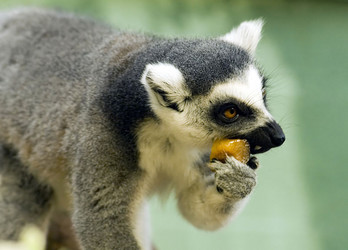
Left: Wild ring-tailed lemur feeding in a tree in Isalo, Madagascar, © 2005 Daniel. Right: Captive lemur eating fruit. © Chris_huh.
Predators
One type of animal that ring-tailed lemurs look out for are hawks; the grey harrier hawk, for example. When a hawk passes by overhead, the lemurs sound a high-pitched shriek alarm call, and move downward to lower bushes to conceal themselves. If a lemur recognizes a ground animal as a potential predator, they begin a series of clicks and synchronized barks and stare the animal down. Primatologist Alison Jolly noted in 1966 that when she walked past a troop of lemurs at night, they began to bark once they noticed her presence. Since the spread of modern humans throughout Madagascar, dogs and cats have also been introduced as predators.
Behaviour
Daily routine
After waking, ring-tailed lemurs enjoy sunning themselves in the early morning. Because of their limp, outstretched arms and half-closed eyes in this position, sunning resembles a meditation pose. After morning feeding, they partake in a daily siesta, by stretching out on a tree branch and falling asleep. It is done in a group, and sometimes lemurs will sleep while in contact with each other.


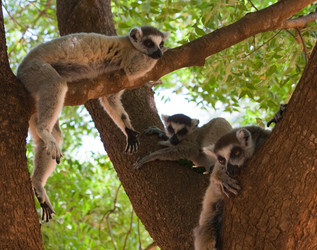
Left: Captive lemur sunbathing, © 2006 Maree Reveley. Right: Wild lemurs at Berenty Reserve, Madagascar relaxing in a tree at mid-day, © 2007 Steve Johnson
Locomotion
L. catta walks or runs quadrupedally on the ground and on the tops of branches, tail standing up for balance. Unlike monkeys, they do not usually hang from the bottoms of tree branches or brachiate to move.
Intelligence
In comparison to other primates, lemurs score low on intelligence tests. They seem to lack the concept of searching through and manipulating objects in order to receive rewards. Jolly found that L. catta tended to ignore a toy puzzle that was offered to them to play with, as well as other inanimate objects that were not food. When presented with a situation such as food placed inside a bottle, L. catta would grab the bottle and poke around with its nose and mouth instead of reaching inside with its hand.
Social Interactions
L. catta live in troops of around 20 members. Troops travel together from tree to tree when looking for food or when deciding where to stay for siesta. They often sit together in clumps, creating body contact and closeness for grooming. When a lemur wants to be groomed, it presents a body part to a partner, and the partner responds by grasping the fur and licking it or scraping it with a tooth. Grooming is usually done mutually, with both lemurs grooming each other at the same time. Ring-tailed lemurs also take part in play, including chasing each other around in circles and jumping on each other to wrestle. L. catta are very vocal, and use barks, howls, screams, clicks and purring. Primatologist R. J. Andrew commented that the sounds they make are similar to those of cats and dogs.

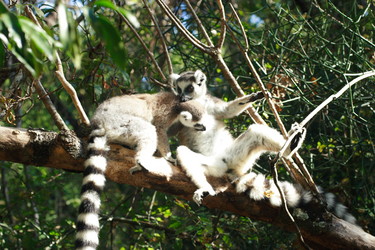
Wild lemurs grooming in a tree at Beza-Mahafaly, Madagascar, © 2007 Teague O'Mara
Reproduction
Sexual Activity
The breeding season of L. catta begins in April. In order to gain access to females, male lemurs participate in various competitive behaviours, including:
- Cuffing. Swatting hands at the other’s face. This can escalate into scratching, grabbing and pulling out tufts of fur.
- Jump-fighting. Standing on the hind legs for intimidation, and grabbing each other from above. Often includes downward slashing of the canines, resulting in injuries.
- Stink-fighting. Alternate scent marking from scent glands and tail-waving between two lemurs standing 3-10 meters apart. Continues until the more aggressive male is established, causing the less aggressive male to retreat.
Copulation begins with two or more males approaching a female, followed by fighting and chasing until one of the males is victorious. The female then presents herself to this dominant male, and he mounts her. The male then undergoes a series of mounting and dismounting to chase away another of his rivals further. After he finally thrusts and ejaculates, the couple stop to groom each other before copulating again. This mating process continues for a few cycles.
Infants
As placental mammals, young ring-tailed lemurs grow in their mothers’ wombs for about 4½ months before being born, and 1-2 offspring are born. At birth, the infant lemurs are about 10 cm long, very thin, and already have the beginnings of rings on the tail. The mothers provide most of the parental care, and carry the young lemurs around on their chests or backs. The young receive grooming from many females of the troop, who are very interested in caring for babies even when they are not their own.


Wild ringtail lemur female with infant at Berenty Reserve, Madagascar, © 2007 Steve Johnson
Conservation
Due to the clearing of trees and the destruction of their habitat, ring-tailed lemurs are an endangered species. There are many conservation efforts in progress, such as by the Lemur Conservation Foundation and the Madagascar Fauna Group. Donations can be made at either website by following the links at the bottom of the page. "Adopt A Lemur" programs are also availabe at the LCF and many zoos.
Pop Culture
- The 2005 animated movie Madagascar features a ring-tailed lemur named Julien, voiced by Sacha Baron Cohen.
- John Cleese, a long-time fan of ring-tailed lemurs, included one in his 1997 movie, Fierce Creatures.
- A television show called Lemur Kingdom on Discovery Channel's Animal Planet focuses on a group of ring-tailed lemurs.
Information on the Internet
- Lemur Conservation Foundation
- National Geographic Video A short video of lemur behaviour.
- National Geographic Kids A webpage for kids to learn about the ring-tailed lemur.
- Primate Info Net, University of Wisconsin Ring-tailed lemur fact sheet.
- Nature: A Lemur's Tale
- Madagascar Fauna Group





 Go to quick links
Go to quick search
Go to navigation for this section of the ToL site
Go to detailed links for the ToL site
Go to quick links
Go to quick search
Go to navigation for this section of the ToL site
Go to detailed links for the ToL site